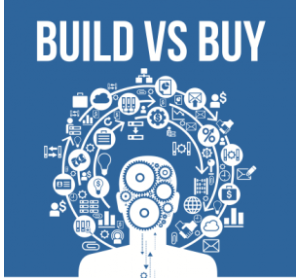Deciding whether to build or buy a solution depends on various factors and considerations. Here are some key points to help you make an informed decision:
Build:
- Unique requirements: If your organization has specific, unique needs that cannot be met by existing off-the-shelf solutions, building a custom solution may be the way to go. This allows you to tailor the solution exactly to your requirements.
- Competitive advantage: If the solution you’re looking for is a core competency of your business and can provide a significant competitive advantage, building it in-house may be beneficial. It allows you to have full control over the development process and intellectual property.
- Integration and customization: If seamless integration with existing systems or extensive customization is essential, building a solution may be preferable. Off-the-shelf solutions may not always provide the flexibility or compatibility required to meet your specific integration or customization needs.
- Long-term cost and scalability: Building a solution can have higher upfront costs, but over the long term, it may be more cost-effective if you have ongoing maintenance and support requirements. Additionally, building your solution gives you more control over scalability as you can adapt it to the changing needs of your organization.
Buy:
- Time and resource constraints: If your organization has limited time, budget, or development resources, buying a pre-existing solution can be a faster and more cost-effective option. It saves you the effort and time required for development, testing, and ongoing maintenance.
- Established expertise: If the solution you need is well-established in the market and there are reputable vendors providing it, buying can be a sensible choice. These vendors have expertise in developing and supporting the solution, which can save you from reinventing the wheel and benefit from their experience.
- Non-core functionality: If the solution you need is not a core competency of your business and doesn’t provide a competitive advantage, buying an off-the-shelf solution can be a practical option. It allows you to focus your resources on core activities while leveraging existing solutions for non-core functions.
- Cost-effectiveness: Off-the-shelf solutions often come with a lower upfront cost compared to building from scratch. Additionally, maintenance, updates, and support are typically handled by the vendor, reducing ongoing costs and responsibilities for your organization.
- Market maturity: If the market offers mature and feature-rich solutions that meet your requirements, buying can be a wise decision. Mature solutions have undergone extensive development, testing, and user feedback, resulting in more reliable and comprehensive offerings.
In many cases, a combination of building and buying may be suitable. For example, you could build a custom solution for your unique requirements while integrating off-the-shelf components for non-core functionality. It’s important to carefully evaluate your organization’s specific needs, available resources, budget, time constraints, and long-term goals when deciding whether to build or buy a solution.


Recent Comments